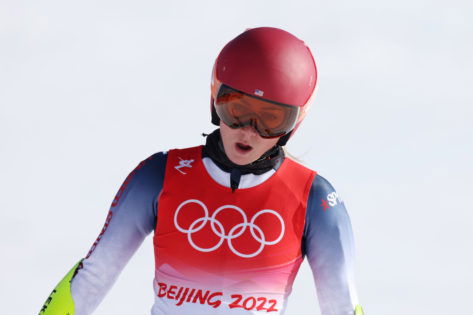There was no bloodcurdling scream, no cinematic crash that stopped time. Just a sharp, sudden moment in Vermont that fractured far more than Mikaela Shiffrin’s body. Months later, the decorated American skier wasn’t battling pain or fear. The queen of the slopes, who once moved with the precision of a metronome down icy giants, now found herself paralyzed not by injury, but by something far more haunting. This wasn’t just about healing. This was about survival.
Shiffrin was diagnosed with PTSD. And she’s not sugarcoating what that means. The crash in Killington during a giant slalom race in November 2024 left her with a puncture wound in her abdomen and major muscle damage. The physical injuries were real, painful, and eventually treatable through surgery. But as her body began to heal, something far more terrifying began to emerge. Shiffrin tried returning to the slopes with her usual determination. But during training, nothing felt right. “I did not feel like myself,” Shiffrin said in an exclusive interview with Players Tribune. “I felt an insane disconnect between my body and my mind,” she added. By the time she underwent evaluation, the diagnosis became clear: PTSD.
“We went through sort of a diagnosis, like a chart basically,” Shiffrin explained. “You kind of almost like check off these boxes and then you check off enough boxes and it’s like… you do qualify for PTSD.” She described trying her hardest to get her body to cooperate, but it wouldn’t respond. “My body’s doing like nothing of what I want it to do,” Shiffrin admitted.
As she peeled back the layers of her experience, Shiffrin began to realize how misunderstood PTSD can be, even for herself. She described it as living behind a foggy film. Like the world was dulled and distant. “Everything’s a little bit darker,” Shiffrin said, comparing it to having “a layer of grease on everything.” Her mind told her it was fine. Her body responded like it was still crashing. The dissonance was crippling.
Her sports psychologist offered a lifeline: exposure. It would take training, again and again, to reconnect her mind with the slopes. “Working through it is exposure,” Shiffrin recalled being told. And slowly, it began to work. By January 2025, she returned to racing. Two months later, she won her 101st World Cup event, a victory that wasn’t just about numbers.
Mikaela Shiffrin’s comeback isn’t just about medals or even redemption. It’s about ownership. She’s made it clear: PTSD isn’t weakness. It’s real. But she’s not running from it anymore. With Milano Cortina 2026 on the horizon, Shiffrin isn’t just chasing glory. She’s reclaiming herself. And en route to build back her strength, Shiffrin had a strict routine to follow.
Who says Mikaela Shiffrin can’t come back stronger than ever?
Mikaela Shiffrin isn’t just aiming for a comeback. Rather, she’s rebuilding herself from scratch. After a painful “stab wound” injury last November that left her navigating core muscle tearing, the alpine skiing legend is channeling her trademark discipline into every rep, stretch, and breath of her strength routine.
Acknowledging the physical toll of recovery, Shiffrin shared, “This has been an ongoing process.” Now in the critical preparation phase for next season, the 30-year-old is zeroing in on the foundation of her athleticism. Her strategy? Reinforce her core, revive coordination, and mobilize her spine—segment by segment. “When I think about bulletproofing my body, I think about working from the ground up, building a strong foundation,” she explained. Shiffrin continued, “Then, the sky is the limit.”
That foundation begins with back-to-basics mobility work, foam rolling the thoracic and lumbar spine, before transitioning into band-assisted cat-cow stretches and core activation. But it’s her strength training where the real rebuilding begins. Crossover lateral step-ups with weight, pull-ups, and hanging side oblique flexion exercises dominate her program. The oblique work, she reveals, has been a cornerstone of her healing journey. “This was really important for me after my injury… to get my core connection back and to work through the oblique muscle tearing,” Shiffrin stated. With each session, she’s not just training to compete, but is training to reclaim her power.
The post Fighting Against Injuries for Comeback, Mikaela Shiffrin Admits to Major Struggles with PSTD appeared first on EssentiallySports.
